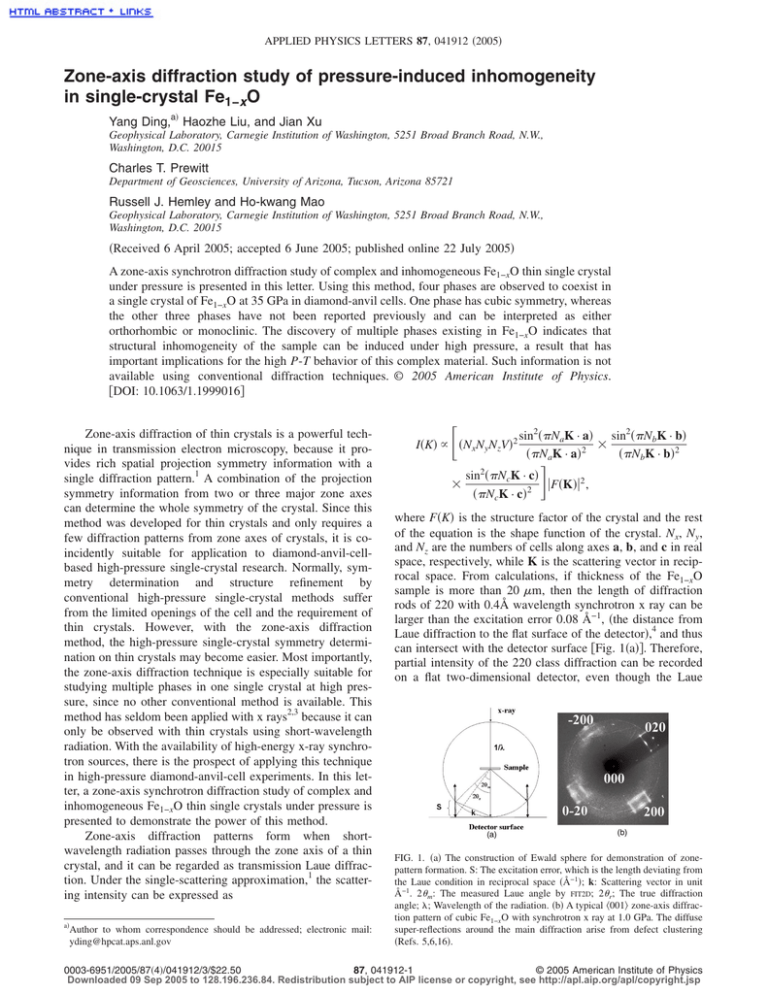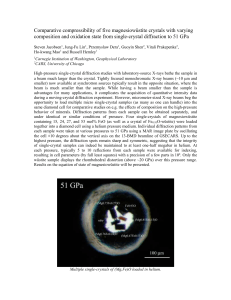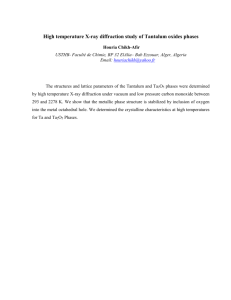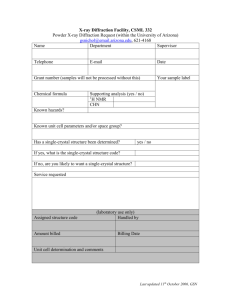Zone-axis diffraction study of pressure-induced inhomogeneity in single-crystal Fe O x
advertisement

APPLIED PHYSICS LETTERS 87, 041912 共2005兲 Zone-axis diffraction study of pressure-induced inhomogeneity in single-crystal Fe1−xO Yang Ding,a兲 Haozhe Liu, and Jian Xu Geophysical Laboratory, Carnegie Institution of Washington, 5251 Broad Branch Road, N.W., Washington, D.C. 20015 Charles T. Prewitt Department of Geosciences, University of Arizona, Tucson, Arizona 85721 Russell J. Hemley and Ho-kwang Mao Geophysical Laboratory, Carnegie Institution of Washington, 5251 Broad Branch Road, N.W., Washington, D.C. 20015 共Received 6 April 2005; accepted 6 June 2005; published online 22 July 2005兲 A zone-axis synchrotron diffraction study of complex and inhomogeneous Fe1−xO thin single crystal under pressure is presented in this letter. Using this method, four phases are observed to coexist in a single crystal of Fe1−xO at 35 GPa in diamond-anvil cells. One phase has cubic symmetry, whereas the other three phases have not been reported previously and can be interpreted as either orthorhombic or monoclinic. The discovery of multiple phases existing in Fe1−xO indicates that structural inhomogeneity of the sample can be induced under high pressure, a result that has important implications for the high P-T behavior of this complex material. Such information is not available using conventional diffraction techniques. © 2005 American Institute of Physics. 关DOI: 10.1063/1.1999016兴 Zone-axis diffraction of thin crystals is a powerful technique in transmission electron microscopy, because it provides rich spatial projection symmetry information with a single diffraction pattern.1 A combination of the projection symmetry information from two or three major zone axes can determine the whole symmetry of the crystal. Since this method was developed for thin crystals and only requires a few diffraction patterns from zone axes of crystals, it is coincidently suitable for application to diamond-anvil-cellbased high-pressure single-crystal research. Normally, symmetry determination and structure refinement by conventional high-pressure single-crystal methods suffer from the limited openings of the cell and the requirement of thin crystals. However, with the zone-axis diffraction method, the high-pressure single-crystal symmetry determination on thin crystals may become easier. Most importantly, the zone-axis diffraction technique is especially suitable for studying multiple phases in one single crystal at high pressure, since no other conventional method is available. This method has seldom been applied with x rays2,3 because it can only be observed with thin crystals using short-wavelength radiation. With the availability of high-energy x-ray synchrotron sources, there is the prospect of applying this technique in high-pressure diamond-anvil-cell experiments. In this letter, a zone-axis synchrotron diffraction study of complex and inhomogeneous Fe1−xO thin single crystals under pressure is presented to demonstrate the power of this method. Zone-axis diffraction patterns form when shortwavelength radiation passes through the zone axis of a thin crystal, and it can be regarded as transmission Laue diffraction. Under the single-scattering approximation,1 the scattering intensity can be expressed as a兲 Author to whom correspondence should be addressed; electronic mail: yding@hpcat.aps.anl.gov 冋 I共K兲 ⬀ 共NxNyNzV兲2 ⫻ sin2共NaK · a兲 sin2共NbK · b兲 ⫻ 共NaK · a兲2 共NbK · b兲2 册 sin2共NcK · c兲 兩F共K兲兩2 , 共NcK · c兲2 where F共K兲 is the structure factor of the crystal and the rest of the equation is the shape function of the crystal. Nx, Ny, and Nz are the numbers of cells along axes a, b, and c in real space, respectively, while K is the scattering vector in reciprocal space. From calculations, if thickness of the Fe1−xO sample is more than 20 m, then the length of diffraction rods of 220 with 0.4Å wavelength synchrotron x ray can be larger than the excitation error 0.08 Å−1, 共the distance from Laue diffraction to the flat surface of the detector兲,4 and thus can intersect with the detector surface 关Fig. 1共a兲兴. Therefore, partial intensity of the 220 class diffraction can be recorded on a flat two-dimensional detector, even though the Laue FIG. 1. 共a兲 The construction of Ewald sphere for demonstration of zonepattern formation. S: The excitation error, which is the length deviating from the Laue condition in reciprocal space 共Å−1兲; k: Scattering vector in unit Å−1. 2m: The measured Laue angle by FIT2D; 2r; The true diffraction angle; ; Wavelength of the radiation. 共b兲 A typical 具001典 zone-axis diffraction pattern of cubic Fe1−xO with synchrotron x ray at 1.0 GPa. The diffuse super-reflections around the main diffraction arise from defect clustering 共Refs. 5,6,16兲. 0003-6951/2005/87共4兲/041912/3/$22.50 87, 041912-1 © 2005 American Institute of Physics Downloaded 09 Sep 2005 to 128.196.236.84. Redistribution subject to AIP license or copyright, see http://apl.aip.org/apl/copyright.jsp 041912-2 Appl. Phys. Lett. 87, 041912 共2005兲 Ding et al. FIG. 2. 共Color online兲 The images of a Fe1−xO single-crystal in a diamondanvil cell at 35 GPa and the corresponding observed diffraction patterns from Locations I, II, and III of the sample in a diamond-anvil cell. The indexing of each pattern has also been shown. The inserts in Patterns III are the enlarged splitting of diffraction class 101. condition is not exactly satisfied. The excitation errors, due to the deviation from the Laue condition, can be corrected in d-spacing measurement as dreal = dmeasured 1 cos measured . Fe1−xO, 共wüstite兲, a fundamentally important material in condensed-matter physics, chemistry, and earth science,7,8 is a rock-salt 共B1兲-type structured nonstoichiometric iron oxide, and it is commonly incommensurately modulated with long-range ordered defect structure.5,6 Two high-pressure phase transformations have been reported from previous powder diffraction studies. One is from the ambient pressure B1 phase to a rhombohedral phase near 15–18 GPa at room temperature,9–11 and the other is from rhombohedral to a B8 共or anti-B8兲 phase around 74 GPa at 900 K.12 Here, we reexamined the spatial symmetry changes in Fe1−xO under pressure with zone-axis diffraction method. The Fe1−xO sample was prepared by cold-pressing reagent-grade hematite 共Fe2O3兲 into centimeter-sized pellets. And then, the hematite pellets were held for ⬃24 h at 1200 °C and 10-11 bars f O2 in a CO/ CO2 gas-mixing furnace.13 The cell parameter of the Fe1−xO was measured by x-ray diffraction to be a = 4.303共2兲Å, corresponding to Fe0.93O.14 High pressures were generated between two gem-quality single-crystal diamonds with 400 m culets in a symmetric diamond cell. One single crystal of Fe1−xO about 70⫻ 35 ⫻ 20 m3, cut along the 兵001其 plane, was placed into a 120 m hole that was drilled in a 45 m thick stainless-steel gasket. One small ruby chip was added as a pressure calibration standard, and a 4:1 methanol–ethanol mixture was used as the pressure medium. The diffraction experiments were performed at beamline 16-IDB, High-Pressure Collaborative Access Team of the Advanced Photon Source, Argonne National Laboratory. The diamond-anvil cell was mounted on a stage that could be rotated up to 10° around the vertical and horizontal axes for alignment purposes. Zone-axis diffraction patterns were taken along the 具001典 zone axis of cubic Fe1−xO and recorded with a Mar345 image plate. Diffraction data were analyzed with the FIT2D program.15 The measurements were carried out up to 35 GPa with about a 2 GPa increase in pressure at each step, and a typical 具001典 zone-axis diffraction pattern from cubic Fe1−xO at low pressure is displayed in Fig. 1共b兲. A long-range defect cluster order-disorder transition was observed around 14 GPa from the incommensurate superstructure reflections. Then, the cubic Fe1−xO transformed into the rhombohedral phase after 19.8 GPa. The detailed description of the results below 25 GPa will be reported elsewhere.16 Surprisingly, the rhombohedral phase in turn transformed into four phases at 31.9 GPa. Diffraction patterns from three locations—I, II, III—of the sample indicate four phases coexisting in the single crystal pattern of Fe1−xO taken at 35 GPa are displayed in Fig. 2. The diffraction pattern from Phase I of the sample shows a projection symmetry of 4mm1R,4 which is the same as that of the phase below 19.8 GPa and suggests a cubic symmetry 共Fig. 2兲. The lattice parameter a = 4.100 Å was obtained from fitting the pattern. The appearance of 310 class diffraction, which should be absent in the B1 structure, probably arises from structure defects. The simulation of the diffraction patterns using Fm3m along the 具001典 zone axis is shown in Fig. 3共a兲. The highest projection-diffraction symmetry from Phase II shown in Fig. 2 is 2mm1R.4 Since no other higher Downloaded 09 Sep 2005 to 128.196.236.84. Redistribution subject to AIP license or copyright, see http://apl.aip.org/apl/copyright.jsp 041912-3 Appl. Phys. Lett. 87, 041912 共2005兲 Ding et al. symmetry zone-axis pattern was obtained due to the limited opening angle of the diamond-anvil cell, it is difficult to uniquely determine the space group of the phase. Since the pattern was taken along the highest symmetry zone-axis of cubic Fe1−xO, it is possible that the zone-axis pattern of Phase II, transformed from a nearly cubic phase, still bears the highest symmetries. If so, the symmetry of the zone-axis pattern 2mmm1R indicates that the symmetry of Phase II is not higher than orthorhombic. Considering that the principal a,b axes of Phase II are parallel to 具220典 of cubic Phase I, Phase II is most likely structurally coherent with Phase I. Symmetries lower than orthorhombic may introduce tilt phase boundaries which may increase the free energy of the system and not favor the formation of the new phases. Indexing according to orthorhombic symmetry shows h + k = 2n, or h + k + l = 2n, indicating a C or I lattice. Accordingly, the highest-symmetry space group that can yield the same diffraction patterns is Cmmm or Immm. The measured lattice parameters a and b are 4.618Å and 4.970Å, respectively. With the assumption that Phase II has the same stoichiometry as that of cubic Fe1−xO 共Fe:O close to 1:1兲, and the Fe ions are octahedrally coordinated by oxygen atoms, then, Cmmm structure has a closer structural relationship to the B1 structure. The simulation of the diffraction pattern from Phase II using symmetry Cmmm along the 具001典 zone axis is shown Fig. 3共b兲. Since the lattice parameters a and b of Phase II are larger than that of cubic Phase I, c must be smaller than 3.00Å, thus ensuring a volume decrease at phase the transformation. The diffraction pattern from Location III of the sample has a symmetry similar to that of Phase II 共Fig. 2兲, but it contains two phases shown by the splitting of some diffraction. If we treat the splitting diffraction as the same diffraction, then the diffraction from Location III has symmetry similar to that of Phase II, and thus can be indexed using orthorhombic symmetry Cmmm. Two lattice parameters of the phases are measured as a = 2.932 Å and c = 4.062 Å, but lattice parameter b cannot yet be determined. However, the 110 diffraction class splits by 0.26° in diffraction angle, indicating that there are two phases 共Phases III and IV兲, and one phase is monoclinic. The two phases have the same lattice a and c but differ in  angle; the  angle of Phase IV is 92° if Phase III is treated as orthorhombic according to calculations.17 The structure of Phase III might be similar to that of Phase II because they have similar diffraction patterns, but they have different lattice parameters. Since Phases III and IV differ only by 2° in the  parameter, then symmetry C2 / m can be the best choice for Phase IV since it is the closest monoclinic symmetry to Cmmm of Phase III and also is able to produce the same diffraction pattern as that from measurement along the 关010兴 zone axis. The simulations of the diffraction pattern from Phases III and IV are shown in Fig. 3共c兲. In the simulations, four of the same diffraction patterns with a few degrees difference in orientation are overlaid for each phase in order to simulate the mosaic spread. It can be noted that the splitting of diffraction class 200 is smeared out by the mosaic spread. Upon the release of pressure, Phases II and III are quenchable to ambient condition. But Phase IV disappears at 13.8 GPa which suggests another phase transition from the monoclinic to the orthorhombic phase. It is noteworthy that some diffraction spots in Phases II and III arise from still other structures, but these cannot yet be identified since their zone axes are not parallel to the x-ray beam. The discovery of multiple phases existing in Fe1−xO indicates that high pressure can induce structural inhomogeneity of the sample. The origin of such pressure-induced inhomogeneity likely results from two mechanisms. One is that the known defect clusters5,6 change their geometry and distribution and develop into complex two-dimensional structural defects in different domains, which in turn trigger multiple phase transformations under pressure. The stress resulting from the coherent structures may also have an influence on the lattice parameters and structures of coherent phases. The second mechanism is that compositional fluctuations, which occur during synthesis,18 develop into different phases upon compression. The observed complexity also indicates that Fe1−xO cannot be treated simply as an Fe–O binary system, but a quaternary system including ferrous and ferric iron, oxygen, and vacancies. Consequently, the discovery of pressure-induced inhomogeneity of Fe1−xO may result in the reconsideration of the interpretation of its electronic/ magnetic properties measured under high pressure. Through this study of Fe1−xO, the new diamond-anvil-cell-based zone-axis single-crystal technique is shown to be a powerful tool for investigating inhomogeneous samples at high pressures. The authors are grateful to S. Jacobsen for kindly providing the single-crystal sample and to M. Somayazulu for helpful discussions. They also appreciate M. Phillips for help with the manuscript. This work was supported by DOE/ NNSA 共CDAC兲, NSF, and W. M. Keck Foundation. 1 P. Buseck, J. M. Cowley, and L. Eyring, High-Resolution Transmission Electron Microscopy and Associated Techniques 共Oxford University Press, New York, 1988兲. 2 H. Tajiri, O. Skata, and T. Takahashi, Appl. Surf. Sci. 234, 403 共2004兲. 3 M. Holt, Z. Wu, H. Hong, P. Zschack, P. Jemian, J. Tischler, H. Chen, and T.-C. Chiang, Phys. Rev. Lett. 87, 255501-1 共2001兲. 4 D. B. Williams and C. B. Carter, Transmission Electron Microscopy: A Textbook For Materials Science 共Plenum, New York, 1996兲. 5 F. Koch and J. B. Cohen, Acta Crystallogr., Sect. B: Struct. Crystallogr. Cryst. Chem. 25, 275 共1969兲. 6 T. R. Welberry and A. G. Christy, Phys. Chem. Miner. 24, 24 共1997兲. 7 R. E. Cohen, I. I. Mazin, and D. G. Issak, Science 275, 654 共1997兲. 8 C. G. Shull, W. A. Strauser, and E. O. Wollan, Phys. Rev. 83, 333 共1951兲. 9 H. K. Mao, J. Shu, Y. Fei, J. Hu, and R. J. Hemley, Phys. Earth Planet. Inter. 96, 135 共1996兲. 10 T. Yagi, T. Suzuki, and S.-i. Alkimoto, J. Geophys. Res. 90, 8784 共1985兲. 11 J. Shu, H. K. Mao, J. Hu, Y. Fei, and R. J. Hemley, N. Jb, Miner. Abh 172, 309 共1998兲. 12 Y. Fei and H. K. Mao, Science 266, 1678 共1994兲. 13 Y. Ding J. Xu, C. T. Prewitt, R. J. Hemley, H. K. Mao, A. Cowan, J. Zhang, J. Qian, S. C. Vogel, and Y. Zhao, Appl. Phys. Lett. 86, 052505 共2005兲. 14 B. Simons, Year Book - Carnegie Inst. Washington 79, 376 共1980兲. 15 A. P. Hammersley, S. O. Svensson, M. Hanfland, A. N. Fitch, and D. Häusermann, High Press. Res. 14, 235 共1996兲. 16 Y. Ding, O. Degtyareva, H. Liu, M. Somayazulu, Y. Meng, J. Xu, C. T. Prewitt, R. J. Hemley and H.-k. Mao, 共unpublished兲. 17 For monoclinic crystal, d101 = 1 / 冑共1 / a2 + 1 / c2 + 2 / ac兲cos  / sin2 . Since the d101 of monoclinic Phase IV differs from that of orthorhombic Phase III by about 0.26° in diffraction angle, 共equal to 0.038Å in real space兲, the calculated  lattice parameter for Phase IV is about 92° if the  of Phase III is 90°; the two phases have the same lattice parameter a and c. 18 B. Andersson and J. O. Sletnes, Acta Crystallogr., Sect. A: Cryst. Phys., Diffr., Theor. Gen. Crystallogr. 33, 268 共1977兲. Downloaded 09 Sep 2005 to 128.196.236.84. Redistribution subject to AIP license or copyright, see http://apl.aip.org/apl/copyright.jsp






